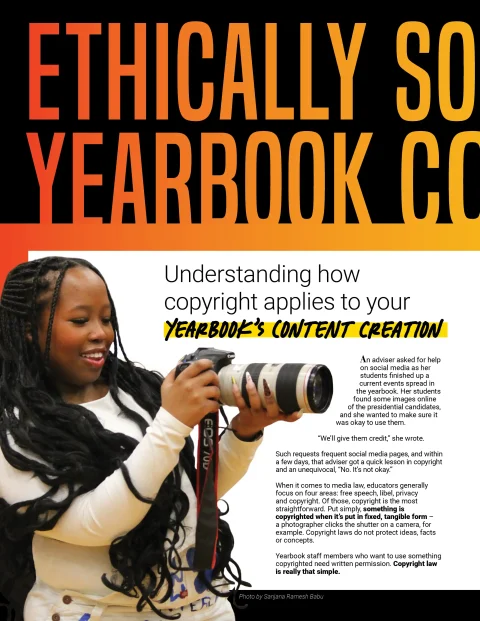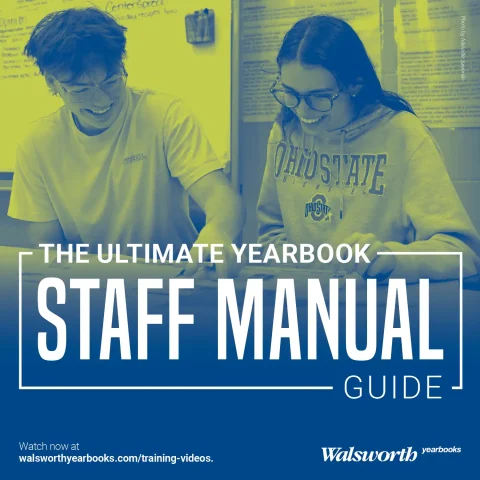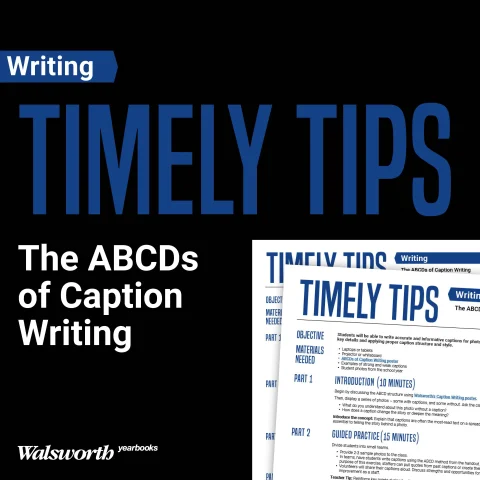An adviser asked for help on social media as her students finished up a current events spread in the yearbook. Her students found some images online of the presidential candidates, and she wanted to make sure it was okay to use them.
“We’ll give them credit,” she wrote.
Such requests frequent social media pages, and within a few days, that adviser got a quick lesson in copyright and an unequivocal, “No. It’s not okay.”
When it comes to media law, educators generally focus on four areas: free speech, libel, privacy and copyright. Of those, copyright is the most straightforward. Put simply, something is copyrighted when it’s put in fixed, tangible form – a photographer clicks the shutter on a camera, for example. Copyright laws do not protect ideas, facts or concepts.
Yearbook staff members who want to use something copyrighted need written permission. Copyright law is really that simple.
Without a Written Agreement
It doesn’t matter who owned the equipment used to take the photo or create the art.
It doesn’t matter if the photographer had a press pass that granted them special access.
It doesn’t matter whether the images were taken as part of a class or not.
It doesn’t have to be registered with the copyright office for it to be copyrighted.
Images remain copyrighted
for 70 years after the
death of the photographer.
The Origin Story
Copyright law is not based on an amendment to the Constitution or legal precedent but rather on Article I, Section 8, Clause 8, which is part of the enumeration of the powers of Congress.
Article I, Section 8, Clause 8: [The Congress shall have Power . . . ] To promote the progress of science and useful arts, by securing for limited times to authors and inventors the exclusive right to their respective writings and discoveries.
State copyright laws remain largely in the shadow of federal copyright law.
Student media staff members may occasionally need to use photos of events they weren’t able to cover personally, so it’s important to know how to get the proper permission to use images.
SCENARIO 1: PARENT PHOTOS
The baseball team gets a new $2.8 million field. However, the ribbon-cutting is held on a Sunday afternoon, and no student staff members can attend. Baseball parents, however, get some great photos. Can a yearbook staff use those images?
Sure. The staff can use the photos with written permission, such as an email from the person who took the photos. Student critique services at state or national journalism organizations want to know that students didn’t take those images, so use a photo credit such as “Photo contributed by…” or “Photo used with permission by…”.
When asking for permission to use the image, make sure that permission comes from the person who actually owns the copyright. Sometimes, students will go to a coach, for example, to get an image. The coach will give it to the student and grant permission to use the image. However, if a parent took the picture, the permission needs to come from the parent.
In addition to crediting the individual image, staff members can list all contributors in the colophon. Advisers should retain printed copies of the permission to use the images – whether that permission comes from a written memo, an email or a text message. Keep these in a file accessible to that adviser’s successor or an administrator.
SCENARIO 2: NATIONAL EVENTS & PUBLIC FIGURES
The yearbook staff wants to cover national politics and how it impacted the school, including pictures of the top candidates, Donald Trump and Kamala Harris. However, the candidates never campaigned anywhere near the school, so staff members never had a chance to take pictures of them. Can the yearbook staff just find an image online and use it?
No. The photographers who took those images worked hard and deserve compensation for their work.
One option is to purchase an image from the Associated Press or Getty Images. A second option is to use one of the supplemental content spreads provided by Walsworth. A third option is to use government photos (you, the taxpayer, own these photos). A fourth option is to find a photographer who has provided images for student media staffs to use.
For example, Gage Skidmore provides all his images of people such as Spike Lee, Mark Cuban, Bernie Sanders, Tulsi Gabbard, Donald Trump, Lindsay Lohan, Glen Powell and other celebrities on Flickr.com, and he makes them available via a Creative Commons license: “Please attribute to Gage Skidmore.” They must be attributed to fulfill the Creative Commons obligations and so readers know student staff members didn’t take them: “Photo used with permission by… .”
The National Scholastic Press Association also created a way for student photographers to share images that other staffs could use. Just visit the NSPA website and look under Resources for Campaign. Any high school or college student can contribute or use images in the collection – with credit.
SCENARIO 3: AI-GENERATED IMAGES
There is no image available for a quote collection sidebar on owning pets. The best option, of course, is to go take a photo for the column, maybe a still-life image in the studio. But some staffs might also consider using artificial intelligence to create an image.
While AI law is evolving, as of right now, images created using AI cannot be copyrighted since a human did not create them. A photojournalist’s code of ethics would preclude using an AI-generated image in place of a news or feature image, but AI is also good at creating images that resemble art more than reality.
AI-generated images should be used with a credit such as “Image generated by AI” or “Image generated by Adobe Firefly using ‘key word’” for complete transparency.
Photographers should consider the ethical implications of using images without knowing the source of the building blocks of those images. Just as the words ChatGPT uses to create a draft of a novel were used elsewhere, the pixels that AI tools, such as Adobe Firefly, Midjourney, DALL-E 3 (OpenAI) and Stable Diffusion (DreamStudio), use came from other images, but legally, they are not copyrighted.
Since laws and regulations can vary from state to state, it’s best practice to check with your school district on any state-specific restrictions on use of AI or the Student Press Law Center (SPLC).
CAVEATS
There are a few other things to know about copyright law. First, copyright is a form of intellectual property right law. The right to own an image cannot be taken away, but it can be given away.
Second, photographers often sign away their rights when signing employment contracts – work for hire. Freelance photographers need to be careful of such agreements when signing contracts.
Third, the Fair Use clause of the copyright law allows limited use of copyrighted material without permission for purposes like criticism, comment, news reporting, teaching, scholarship or research. This is what makes it permissible for a teacher to show a photo in class or for a newspaper to publish an album cover with a review of the album.
Students who want to use an album cover or movie poster to illustrate the top album or movie of the year can do so under the cultural journalism principle that allows journalists to use textual, visual and other quotations of cultural material for purposes of reporting, criticism, commentary or discussion – that constitutes fair use. As Mike Hiestand wrote for the Student Press Law Center, “To qualify, the copyrighted material that you use must be very closely tied to a bona fide news story, news survey, commentary or review.”
OWNERSHIP AGREEMENTS
By default, students own the images they take in lieu of another written agreement. Some advisers feel more comfortable if their student photographers and their parents sign a written agreement of joint ownership to protect both the photographer and the school.
Anthony Mazur, a high school student photographer, encountered just such a roadblock when his school administrators tried to assert that they owned his images because he was taking a class, using school equipment and had special access.
Taylor Potter and Monica Kast wrote for the Student Press Law Center in 2015, “Mazur, then a student at Flower Mound (Texas) High School, was ordered by his school administration to take down a Flickr page where he was selling school sports photos to parents. Months later, the school required all members of the yearbook class to sign an agreement that the district owns the copyright to any work they produce.”
While it took three years and some legal wrangling, Mazur voluntarily dismissed his lawsuit against the Lewisville Independent School District after the district agreed Mazur owned his photos and promised to stop requiring students to sign an agreement giving the district ownership of their photos.
A written agreement in advance, such as the one below,
might have helped both school district officials and student photographers understand their joint rights
DRAFT POLICY – OWNERSHIP OF IMAGES
In accordance with Student Media policy and the United States Copyright Law, Student Media and individual photographers jointly own all images taken on assignment for the Student Media. This does NOT prevent a student photographer from taking pictures on their own, using their own equipment, for profit. It does NOT prevent student photographers from publishing photos they have taken on their own website for portfolio or contest purposes or otherwise displaying them for portfolio or contest purposes. It DOES prevent a photographer from releasing any photos taken while on assignment from Student Media to other media outlets or on social media before they are published (or refused publication) in The Student Media. The Student Media retains exclusive rights to publish in any form photographs taken while on assignment or published in a student media for a period of 12 months. After that, the photographer and Student Media share copyright, and both may publish as desired.
By keeping these points in mind, your staff can create an amazing yearbook full of creative and ethically sourced content that tells the story of your year. And when in doubt, don’t hesitate to reach out to SPLC for free legal guidance, as well as your Walsworth Yearbooks Sales Representative.





